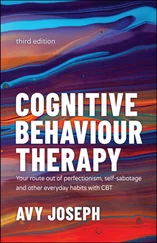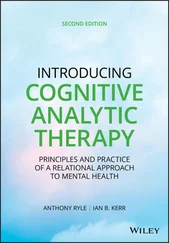5 Part 3: Putting CBT Into Action Chapter 9: Standing Up to Anxiety and Facing Fear Acquiring Anti-Anxiety Attitudes Attacking Anxiety Overriding Common Anxieties Chapter 10: Abolishing Addictions Putting a Name to Your Problem Familiarising Yourself with the Many Faces of Addiction Accepting Yourself and Your Addiction Securing Suitable Support Deciding to Desist Transforming Intention into Action Planning to Prevent Relapse Chapter 11: Building a Better Body Image and Beating BDD Making Friends with the Mirror Taking Advertising and Media Messages with a Pinch of Salt Saluting Your Body for Services Rendered Choosing to Change for All the Right Reasons Chapter 12: Deconstructing and Demolishing Depression Understanding the Nature of Depression Looking at What Fuels Depression Going Round and Round in Your Head: Ruminative Thinking Activating Yourself as an Antidepressant ACTing against Depression Managing Suicidal Thoughts Contemplating Complex Forms of Depression Chapter 13: Sleeping Soundly Assessing Your Sleep Situation Eliminating Unhelpful Sleep Expectations Getting Into a Clean Sleep Routine Chapter 14: Overcoming Obsessions Identifying and Understanding Obsessional Problems Identifying Unhelpful Behaviours Acquiring Anti-Obsessional Attitudes Facing Your Fears: Reducing (and Stopping) Rituals Being Realistic about Responsibility Chapter 15: Overcoming Low Self-Esteem and Accepting Yourself Identifying Issues of Self-Esteem Developing Self-Acceptance Being Inspired to Change Actioning Self-Acceptance Selecting the Self-Help Journey to Self-Acceptance Chapter 16: Cooling Down Your Anger Discerning the Difference between Healthy and Unhealthy Anger Assembling Attitudes That Underpin Healthy Anger Imparting Your Indignation in a Healthy Way Acting Assertively in the Workplace Dealing with Difficulties in Overcoming Anger Chapter 17: Healing Illness Anxiety Analysing the Anatomy of Illness Anxiety Getting to know Medically Unexplained Physical Sensations Minimising Your Fear of Missing an Important Symptom Feeling Secure in an Uncertain Body
6 Part 4: Looking Backwards and Moving Forwards Chapter 18: Taking a Fresh Look at Your Past Exploring How Your Past Can Influence Your Present Identifying What Core Beliefs Are Detecting Your Core Beliefs Understanding the Impact of Core Beliefs Making a Formulation of Your Beliefs Limiting the Damage: Being Aware of Core Beliefs Developing Alternatives to Your Core Beliefs Chapter 19: Moving New Beliefs from Your Head to Your Heart Defining the Beliefs You Want to Strengthen Acting As If You Already Believe Building a Portfolio of Arguments Understanding That Practice Makes Imperfect Nurturing Your New Beliefs Chapter 20: Heading for a Healthier and Happier Life Planning to Prevent Relapse Filling In the Gaps Overhauling Your Lifestyle Living in Line with Your Values Chapter 21: Overcoming Obstacles to Progress Tackling Emotions That Get in the Way of Change Adopting Positive Principles That Promote Progress Tackling Task-Interfering Thoughts Chapter 22: Psychological Gardening: Maintaining Your CBT Gains Knowing Your Weeds from Your Flowers Working on Weeds Tending Your Flowers Chapter 23: Working with the Professionals Procuring Professional Help Tracking Down the Right CBT Therapist for You Making the Most of CBT
7 Part 5: The Part of Tens Chapter 24: Ten Philosophies for Living That Work Assuming Emotional Responsibility: Owning the Way You Feel Thinking Flexibly Valuing Your Individuality Accepting That Life Can Be Unfair Understanding That Approval from Others Isn’t Necessary Realising Love Is Desirable, Not Essential Tolerating Short-Term Discomfort Enacting Enlightened Self-Interest Pursuing Interests and Acting Consistently with Your Values Tolerating Uncertainty Chapter 25: Ten Self-Esteem Boosters That Don’t Work Putting Others Down Thinking You’re Special Trying to Get Everyone to Like You Placing Yourself above Criticism Avoiding Failure, Disapproval, Rejection and Other Animals Avoiding Your Emotions Attempting to Feel More Significant by Controlling Others Over-Defending Your Self-Worth Feeling Superior Blaming Nature or Nurture for Your Problems Chapter 26: Ten Mythical Monsters of Mental Health Psychological Problems Mean You’re Weak I Should Be Able to Get Better on My Own Mental Health Is an Either/Or Issue You Get Better All at Once The Drugs Don’t Work; They Just Make You Worse Certain Types of Psychological Disorders Are Glamorous Mental Illness Is Unpreventable; It’s Just Bad Luck Everyone Can Tell when a Person Has a Mental Illness Having a Mental Illness Means You’re Dangerous Seeking Help Will Go on My Medical Record and Hurt My Future Prospects
8 Part 6: Appendixes Appendix A: Recommended Resources Books Websites Films and Videos Appendix B: Forms The ‘Old Meaning–New Meaning’ Sheet The Cost–Benefit Analysis Form The ‘Tic-Toc’ Sheet The Zigzag Form The Vicious Flower The Task Concentration Sheet The ABC Form I The ABC Form II The Pricing-up Addiction Form The ‘What does my addiction do for me?’ Analysis Form
9 Index
10 About the Authors
11 Connect with Dummies
12 End User License Agreement
1 Chapter 5 TABLE 5-1 Harold’s Task-Concentration Record Sheet
2 Chapter 6 TABLE 6-1 Healthy and Unhealthy Emotions
3 Chapter 8TABLE 8-1 The Cost–Benefit Analysis FormTABLE 8-2 Cost–Benefit Analysis: ‘Costs and Benefits of Saying What Comes Into M...TABLE 8-3 Second Cost–Benefit Analysis: ‘Costs and Benefits of Preparing in My H...
4 Chapter 9TABLE 9-1 Graded Hierarchy of Anxiety
5 Chapter 12TABLE 12-1 Activity Schedule
6 Chapter 17TABLE 17-1 Finding Less Anxiety-Producing Interpretations of Bodily Sensations
7 Chapter 18TABLE 18-1 Beth’s Old Meaning–New Meaning Worksheet
8 Chapter 20TABLE 20-1 Callum’s Value-Based Behaviours FormTABLE 20-2 My Value-Based Behaviours Form
9 Chapter 21TABLE 21-1 Example of a Tic-Toc Sheet
1 Chapter 1FIGURE 1-1: Ais the activating event, Bis your beliefs and thoughts and Cis ...
2 Chapter 2FIGURE 2-1: Catastrophising.FIGURE 2-2: All-or-nothing thinking.FIGURE 2-3: Fortune-telling.FIGURE 2-4: Mind-reading.FIGURE 2-5: Emotional reasoning.FIGURE 2-6: Overgeneralising.FIGURE 2-7: Labelling.FIGURE 2-8: Demands.FIGURE 2-9: Mental filtering.FIGURE 2-10: Disqualifying the positive.FIGURE 2-11: Low frustration tolerance.FIGURE 2-12: Personalising.
3 Chapter 3FIGURE 3-1: The ABC form I.FIGURE 3-2: An example of a filled-in ABC Form II.
4 Chapter 4FIGURE 4-1: Photocopy and fill in your own Behavioural Experiment Record Sheet....
5 Chapter 6FIGURE 6-1: The anatomy of emotion.FIGURE 6-2: Notice the similarities in your physical sensations.
6 Chapter 7FIGURE 7-1: A vicious flower of panic.
7 Chapter 8FIGURE 8-1: The Problem-and-Goal Sheet.
8 Chapter 9FIGURE 9-1: Common physical sensations of anxiety.FIGURE 9-2: Your anxiety reduces with each exposure to a feared trigger.
9 Chapter 10FIGURE 10-1: Jack’s Pricing-up Addiction form.FIGURE 10-2: Percy’s Pricing up Addiction form.FIGURE 10-3: Kelly’s ‘What does my addiction do for me?’ analysis.
10 Chapter 11FIGURE 11-1: The amount of emphasis people with unhealthy body image assume oth...FIGURE 11-2: A more accurate measure of the components of attractiveness.
11 Chapter 12FIGURE 12-1: The cycle of depression.
12 Chapter 14FIGURE 14-1: The starting point for your responsibility pie chart.FIGURE 14-2: Theresa’s responsibility pie chart.
13 Chapter 15FIGURE 15-1: Which do you see first: the big I or all the little i s?
14 Chapter 18FIGURE 18-1: The core beliefs dartboard and Beth’s dartboard, showing the three...FIGURE 18-2: The prejudice model illustrates how you sometimes distort positive...FIGURE 18-3: Make a formulation of your beliefs with the help of this form.
Читать дальше












